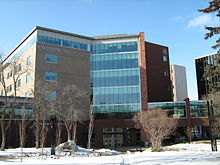University of Alberta Faculty of Engineering
 The Engineering Teaching and Learning Complex (ETLC) | |
| Type | Faculty |
|---|---|
| Established | 1908 |
| Affiliation | University of Alberta |
| Dean | Fraser Forbes |
| Undergraduates | 4,441[1] |
| Postgraduates | 1,519[1] |
| Location | , , |
| Website | www |
The
History
Engineering classes have been taught at the University of Alberta since it opened in 1908.
Programs
Undergraduate
The undergraduate bachelor's degree program for engineering is based on a 4-5 year program. The traditional program involves taking two terms (fall and winter) for four years to complete a degree. The co-op program involves intermittent work placement terms, within a 5-year period. Co-op programs are usually in higher demand by students than the 4 year "Traditional" programs, and thus the entrance GPA tends to be higher.[4]
New students to engineering must first take two terms of general engineering courses before specializing into various departments. These courses include introductory
Departments
The departments in engineering at the University of Alberta are as follows:
- Oil SandsOptions)- The Chemical Engineering program is the top program in Canada by a wide margin and is in the top 5% in North America. This ranking is against 177 programs in both the U.S. and Canada. This ranking is based on total refereed publications over a 5-year period as listed in the Science Citation Index of ISI.[Source?]
- Petroleum Engineering)
- Engineering Physics)
- Mechanical Engineering
- Biomedical Engineering, the department hosts graduate and PhD students.
Graduate
All five Faculty of Engineering departments offer MSc, MEng, and PhD programs.[6]
Key Research Facilities
- The nanoFAB - An open access micro and nano fabrication research facility.[7]
- The National Institute for Nanotechnology (NINT) – A joint venture with the National Research Council Canada (NRC) that hosts facilities and research programs involving more than 300 researchers.[8]
- The Alberta Centre for Surface Engineering and Science (ACSES) – A $20M multi-disciplinary integrated surface characterization and modification facility.
- The Oil Sands Tailings Research Facility – A facility designed to support substantial fundamental tailings research at a pilot scale (600 and 2000 kg solids per hour) and accommodate multiple, concurrent interdisciplinary research projects.[9]
- The Peter S. Allen Magnetic Resonance Research Centre - A facility located inside the University Hospital that houses 1.5 T, 3 T and 4.7 T full-body MRI systems.[10]
Campus

A new structure, the Donadeo Innovation Centre for Engineering (D-ICE) was erected between the Chemical and Materials Engineering Building and the Windsor Car Park.[14]
References
- ^ a b "Students". University of Alberta. 2017–2018. Retrieved June 28, 2018.
- ^ "University of Alberta". AUCC. 2007. Archived from the original on 2008-03-14. Retrieved 2008-03-01.
- ^ "Background". Faculty of Engineering. 2008. Retrieved 2008-03-01.
- ^ "Admission GPAs for Second Year Programs". University of Alberta. 2006. Retrieved 2007-06-29.
- ^ "University of Alberta BSc in Engineering - Qualifying Year". University of Alberta. Retrieved 2022-03-15.
- ^ "Degrees and Programs - Faculty of Engineering - University of Alberta". www.engineering.ualberta.ca. Retrieved 2016-08-26.
- ^ "nanoFAB - Fabrication and Characterization Facility". www.nanofab.ualberta.ca. Retrieved 2016-08-26.
- ^ "NINT". www.nint.ualberta.ca. Retrieved 2016-08-26.
- ^ "Creating tomorrow's technologies | OSTRF". www.ostrf.com. Retrieved 2016-08-26.
- ^ "Peter S. Allen MR Research Centre, University of Alberta - Edmonton, Alberta, Canada". www.invivonmr.ualberta.ca. Retrieved 2016-08-26.
- ^ "ETLC/ECERF Opening". University of Alberta. 2002. Retrieved 2007-06-29.
- ^ "NREF Opening". University of Alberta. 2004. Retrieved 2007-06-29.
- ^ "NINT Opening". University of Alberta. 2006. Retrieved 2007-06-29.
- ^ "Innovation Centre for Engineering". University of Alberta. 2011. Retrieved 2011-12-02.
